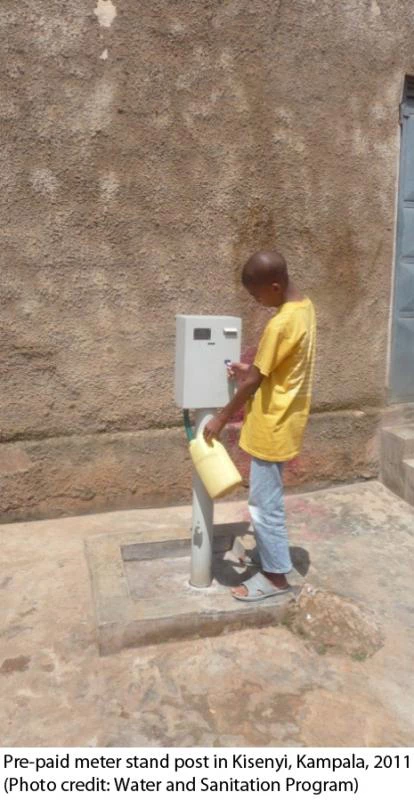Lessons from a recent case study on informal settlements in Kampala, Uganda, where water services were expanded to reach the poor in less than a decade, indicate that pro-poor policies are critical to increasing water coverage for poor people. What is telling is that revenues and subsidies earned from serving the non-poor, combined with applying rigorous business principles, were equally important in sustaining these services.
In the case of Kampala, the utility improved its financial viability by more than doubling the number of connections from 59,000 in 2004 to 146,000 in 2009 and tripling revenues between 2004 and 2010. As a result of the policy, an additional 2,500 yard taps and 660 new public points were installed in the informal settlements. Although this was a small fraction of total new connections in the period, since they were shared, they reached 21% of the approximately 466,000 new people served during this period, those in the lowest socio-economic quintiles.
Three lessons emerged from the experience and rate of expansion (Figure 1) in Kampala:

The first lesson that emerged is that pro-poor policies at the national and utility level not only provide guidance in managing these issues, but also provide a mandate for resource allocation.
The Government of Uganda through the Directorate of Water Development analyzed the problems facing the poor through a water sector review of the pro-poor performance of policies, strategies, and practice in 2004. The review revealed that flat tariffs charged at public water points were not benefiting the poor because of significant mark-ups charged by middlemen. It also showed that the intended consumption subsidies embedded in the tariff were actually benefiting customers who were already connected to the network, and not the poor who rely on kiosks or yard taps.
In 2004, the Ministry of Water and Environment (MoWE) unveiled their new policy to redress these anomalies, proposing to intensify the network in poor areas, adjust the tariff across user categories, subsidize consumption of public water points used in informal settlements, and improve targeting of the neediest users while aiming for 100% coverage for water supply and sanitation services by 2015. The National Water and Sewerage Corporation (NWSC) mandated by Government to provide water and sanitation services in urban areas, then built on this to elaborate a pro-poor strategy and a range of pro-poor service delivery mechanisms.
- They defined the poor, and conducted a mapping exercise to understand the needs and location of this target group. Poor households were defined as those that (i) had monthly incomes of less than UGX80,000 (US$48), (ii) live in clustered settlements with a high crowding index of up to 14 persons per household (iii) consume no more than 20 liters per capita per day or less and (iv) do not have their own house connection and mainly use Public Water Points.
- They adopted an Affordable Connections Policy in 2004. This stipulated that the NWSC would connect all customers for free if located within 50 meters of the NWSC’s water mains, and would share the cost of connections beyond 50 meters.
- Three years later an Urban Pro-Poor Branch was set up and staffed with highly skilled social scientists assigned to promote, plan and support water supply and sanitation service expansion in poor, unserved settlements of Kampala.
- Multiple levels of service were provided to new domestic customers, allowing them a choice of individual house connections, public water points, and shared yard taps. 43% of the new public water points were managed by women, ensuring shared economic opportunities in the water resale business.
- During the following year (2008), the NWSC started pilot-testing automated or pre-paid public water points. This was hugely successful in removing the cost incurred by the poor from the middleman, assuring consumption subsidies reached those who needed them, and 24/7 access.
- In the same year, with support from the Global Partnership for Output-Based Aid (GPOBA) they initiated A Pro-Poor Targeting Project, to subsidize water supply connections including shared yard taps and prepaid PWPs/kiosks, in specific poor settlements of Kampala.
 The second lesson underscored the wisdom that a financially sound and well performing utility is a necessary though insufficient condition to serve the poor. By beginning with institutional reforms, the Government of Uganda (GoU) prioritized the autonomy and viability of the utility as a first step.
The second lesson underscored the wisdom that a financially sound and well performing utility is a necessary though insufficient condition to serve the poor. By beginning with institutional reforms, the Government of Uganda (GoU) prioritized the autonomy and viability of the utility as a first step.
In 2000 the government amended the Statute and Act of the utility, the National Water and Sewerage Corporation (NWSC) which provided substantial autonomy to the NWSC to operate services on a financially and commercially viable basis. They removed the requirement to service debts incurred for earlier capital investment. Tariffs were subjected to automatic annual indexation against inflation, exchange rate, foreign price index, and electricity tariffs. This protected the company’s financial equilibrium and maintained real value for the tariff. These automatic adjustments helped ensure that the NWSC was able to recover all its operating and maintenance costs and to make provision for depreciation. The policies adopted by NWSC for non-poor domestic, government and industrial customers as well as for the poor underpinned viability as well by assuring increases in revenue.
NWSC coupled financial viability with improved efficiency of its operations by employing better trained staff, setting key performance contracts through geographically independent managed water supply operations, installing a new customer billing and revenue management system, improving community liaison and customer care, and improving efficiency in procurement and works management systems.
The third lesson that emerged is that the National Water and Sewerage Corporation looked for and executed pro-poor solutions iteratively, overcoming challenges and leveraging their experience within the organization in serving their less endowed consumer segment.
In many instances land ownership patterns presented challenges to access by the poor to domestic water connections. The utility, absentee landlords, and squatters all faced disincentives to invest due to the “mailo” land tenure system, affecting 52% of the land in Kampala. A “mailo”unit, the equivalent of 640 acres, is the term used in Kampala to describe a land tenure system that came into effect when the Kingdom of Buganda signed an agreement with the British administered Uganda Protectorate in 1900. Many of the landowners are absentee, and the tenants or squatters living on Mailo land often have no ownership documents or means of making decisions although they have lived there for many years. To overcome the challenge of installing public water points on these plots, the NWSC staff engaged in tactful negotiations with tenants, land owners and the municipality.

Another challenge was the non- payment by the poor of bills for public water points and yard taps and resulting disconnections, combined with the tendency by the poor to revert to unsafe sources throughout the city. Compliance gradually increased and disconnections reduced over the years.
As an alternative to the public water points, NWSC introduced pre-paid meters. These meters ensured that revenue was collected by charging the customer up-front for the services, thus ensuring an affordable, 24/7 supply, but repairing them was costly with technicians needing to be flown in from South Africa. In addition a weak token distribution system made demand outstrip supply, and this became a source of angst to women and children relying on this system for water collection.
Yet another challenge was the lag in addressing access to sanitation. Strategies and investments for on site sanitation and sewerage were thought through much later, and have taken longer to take root. All in all, it was clear that in the face of all these challenges NWSC was committed to learning by doing what worked best, for their consumers and for the health of the Corporation.
The case establishes that when expanding water services in urban areas, policies that are both poor-inclusive and pro-poor matter. Poor-inclusive policies lay emphasis on caring for the goose that lays the proverbial golden egg – as shown by the attention paid to getting non-poor consumers to subsidize the poor, and in harnessing the science of effective business practice. The characteristics of pro-poor policies on the other hand, abandon the restrictions of classic utility service design and explore a menu of affordable options, mastering the issues and perspectives of citizens in informal settlements, adopting innovative technical solutions, and dedicating the financial and human resources necessary to ensure that poor people as a segment, have services that work for them.




Join the Conversation